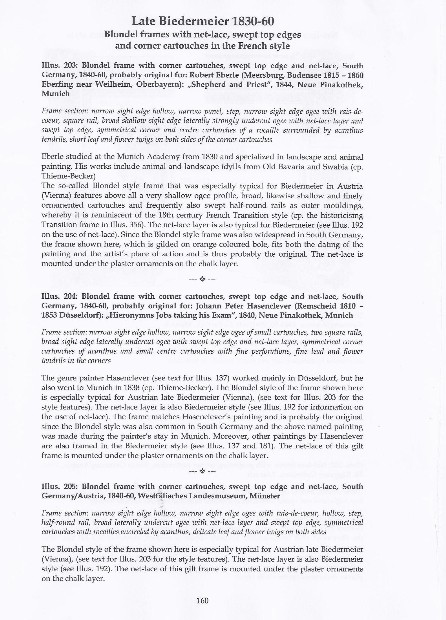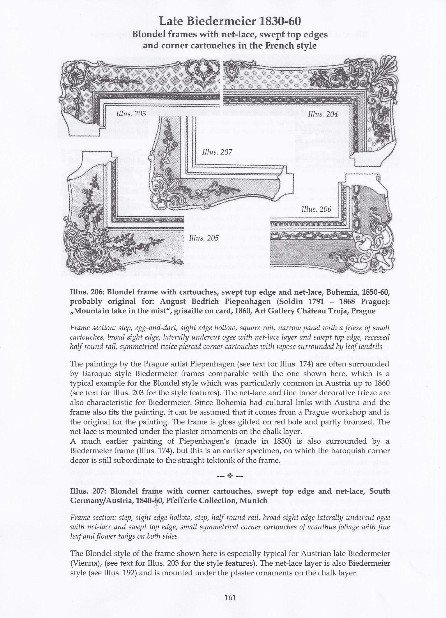schmitzrahmen.de
Volume 2
"Schmitz Compendium of European Picture Frames, 1730-1930:
Neoclassicism, Romanticism, Biedermeier, Impressionism,
Historicism, Jugendstil"
first systematic overview of picture frames: classification, age determination, profiles, decors, materials, construction, origins, historical background, information about artists and their framing preferences, reference literature, register of artists, frame makers and materials
320 pages
444 drawings of frame corners
11 photos of constructions
Format 27 x 21 cm
Language: English
Hardback with gold print, bound with thread stitching
ISBN 978-3-00-039567-3
The lexicon is especially suitable for restorers, curators, gallerists, frame and antique dealers, art and picture frame collectors, frame makers, auction houses, academies, art colleges and art institutes.
This volume classifies and systemizes hitherto mainly unresearched 19th century picture frames from the periods of Neoclassicism, Biedermeier, Romanticism. Historicism and Jugendstil.
Exposée
With their detail and extensive visual material, the above named publications make im-portant contributions to the research in the art of picture framing in the 19th century. How-ever, only selected segments have been dealt with. A general, systematic overview of all 19th century trends, with their respective picture frames to enable restorers, gallerists and museum experts to get as the fastest, exactest classification of a present frame possible has been lacking up to now.
With this book it is hoped that readers may be provided with an overview of European pic-ture frames from 1730 - 1930, from Early Neoclassicism through Biedermeier and Romanti-cism to Historicism and Jugendstil. The epoch considered here, defined as the "19th century" is extended deliberately beyond the 19th century, since Neoclassicism as the 19th century trend began as early as the early 18th century and Historicism and Jugendstil continued until about 1930.
The aim of this book is to give a comprehensive portrayal and systematic and lexical pro-cessing above all of the relation of the described frames to the corresponding 19th century painters and also information on the framing practices and preferences of specific painters.
The main part of the book consists of a lexicon containing 444 drawings of frame corners with cross-sections, which are initially classed according to epoch (Neoclassicism, Romanti-cism, Biedermeier, Historicism, Jugendstil). Within this classification, in the areas Neoclassi-cism and Biedermeier a distinction is then made between early, high and late forms, which are again subdivided according to their special features.
In contrast, for Historicism from about 1860, in which historical styles were copied exactly, classification has been made according to the aspect of the respective style and in particular, a classification as replicas of Italian, French, Spanish and Dutch/Flemish models and those of the Alpine Regions. Within these classes, the quoted styles are shown in chronological order and finally according to landscapes (e.g. Italianizing frames in Renaissance style, fol-lowed by those in Baroque style and below that e.g. Sienese cassetta frames, Bolognese panel frames…). The chapter on Historicism concludes with neoclassicist revival frames, for which the quoted styles are also sorted chronologically.
The final chapter then describes some of the frames in the transition from Historicism to Jugendstil and also some individual artist frames.
The drawings of the frame corners with their cross-sections are always on the top half of the right hand pages. This facilitates rapid browsing when searching for the right equivalent of a present frame. The Figures are also always discussed on the same page spread, which avoids the annoyance of having to turn the page back and forth between text and Fig.
The text for an illustration is always preceded by a description of the panels and decorations. The description of the frames always includes information about style, material, special features, regional distribution where appropriate, cross-references and literature and, above all, information about the framed painting, its artist and his relation to the frame. Consideration is given to whether the frame originally belonged to the painting and which type of frame is used mainly by a painter or artistically related painters. Here, brief bio-graphical data of the respective artist and numerous cross-references to comparable frames can also be found.
In the appendix to the book, an alphabetical list makes it possible to search according to the artist.
If, for example, you want to know by which frame Franz von Lenbach's paintings are usually surrounded, in the list, under "Lenbach, Franz von", you can find references to the corre-sponding illustrations under the rubric "original", "probably original", "contemporary" or "not original".
In the appendix there are also short lists of workshops and of unusual, but for the 19th century typical materials for making picture frames, with references to the corresponding illustrations in the lexicon.
The lexicon is preceded by a history of picture framing art in the 19th century (in the wider sense). Here, first and foremost there is a discussion of the historical backgrounds that pro-vide information on the preconditions for the development of specific styles. The different frame forms are each discussed with a figure of a "prototype"(a particularly typical example).
Subsequently, kinds of construction are presented that are typical for the 19th century, some of which can be assigned to specific regions. Some of these are illustrated with the author's photographs that allow the reader to take a look behind the frame. For the back of a frame is often just as instructive as the front, since the construction and materials are often of help if the style of the frame alone does not permit clear classification and dating.
The book shows frames from collections of paintings in 16 European museums in Berlin, Munich, Weimar, Cologne, Hamburg, Bremen, Hannover, Münster, Dresden, Prague, Bu-dapest, London, Paris and Amsterdam.
In addition, numerous frames from five big German frame collections were included, as the collections offered the opportunity of examining the backs of the frames, which enables an overview of the types of construction characteristic for the 19th century.
My grateful thanks go to the frame collectors, dealers and manufacturers Christel Reuther, Karl Pfefferle and Matthias Hornsteiner (the Riggauer collection) in Munich, Martin Dickel in Hamburg and F. G. Conzen in Düsseldorf for their kind assistance.
For the lexicon, drawings of the frame corners with their cross-sections were made for all the frames discussed, since drawings frequently reproduce the ornaments more clearly and concisely than photographs that often obscure details of shadows. Moreover, drawings make it possible to display the panels compactly in combination with the frame corners and their ornaments. The drawings were made from the author's photographs.

